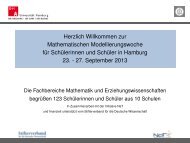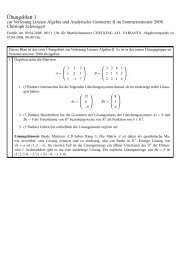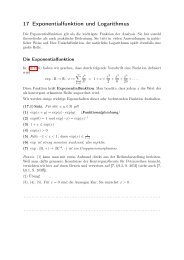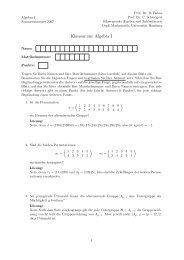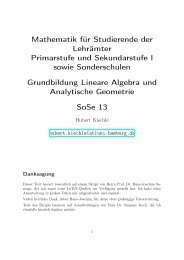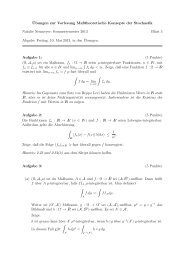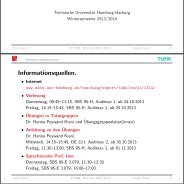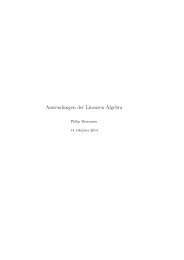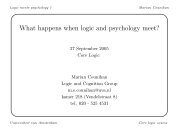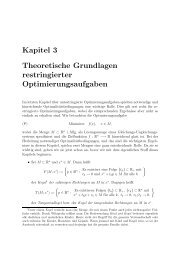pdf file
pdf file
pdf file
You also want an ePaper? Increase the reach of your titles
YUMPU automatically turns print PDFs into web optimized ePapers that Google loves.
Conversely, using the dualities, we find for any pairing a morphism ψ ∈ Hom(A, ∨ A) such that<br />
the operations are inverse.<br />
A pairing is obviously non-degenerate, if and only if the morphism Φ is an isomorphism.<br />
Similarly, invariance of the pairing amounts to the fact that Φ is a morphism of left modules.<br />
This can be seen graphically and is relegated to an exercise.<br />
✷<br />
Definition 3.1.21<br />
A Frobenius algebra in a rigid monoidal category C is an associative unital algebra A in C<br />
together with the choice of one of the following three equivalent structures:<br />
1. A (Δ, ɛ)-Frobenius structure on A.<br />
2. A κ-Frobenius structure on A.<br />
3. A Φ ρ -Frobenius structure on A.<br />
Example 3.1.22.<br />
It is instructive to write down explicitly a distinguished Frobenius algebra structure on the<br />
group algebra K[G] of a finite group.<br />
1. The bilinear form is defined on the distinguished basis by<br />
κ(g, h) = δ gh,e for all g, h ∈ G .<br />
This form is obviously non-degenerate and invariant, κ(gh, l) = δ ghl,e = κ(g, hl) for all<br />
g, h, l ∈ G.<br />
2. The corresponding Φ ρ -Frobenius structure is the morphism<br />
Φ ρ : K[G] → K(G) = K[G] ∗<br />
g ↦→ δ g −1<br />
To show that this is indeed a morphism of left modules, we have to show Φ ρ (hg) = h ⇀<br />
Φ ρ (g). Indeed, evaluating this on x ∈ G, we find<br />
(h ⇀ δ g −1)(x) = δ g −1(xh) = δ g −1 h −1(x) = δ (hg) −1(x) for all x ∈ G .<br />
3. We can finally deduce the (Δ F , ɛ F )-Frobenius structure, where we added an index F to<br />
the Frobenius coproduct and counit to distinguish them from the Hopf coproduct and<br />
counit. We find<br />
ɛ F (g) = δ g,e and Δ F (x) = ∑ h∈G<br />
gh −1 ⊗ h<br />
which is indeed different from the coproduct and counit giving the Hopf algebra structure<br />
on K[G]. Note that here, in contrast to the Hopf coproduct, the product in the group<br />
enters.<br />
We can now state:<br />
Theorem 3.1.23.<br />
Let H be a finite-dimensional Hopf-algebra with left integral λ ∈ H ∗ . Then H is a Frobenius<br />
algebra with bilinear pairing<br />
κ(h, h ′ ) := λ(h ∙ h ′ ) for h, h ′ ∈ H .<br />
62




